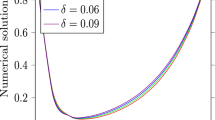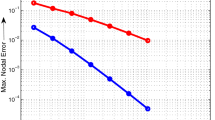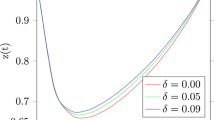Abstract
The main aim of this paper is to address a novel exponentially fitted finite difference method for the treatment of a class of 2nd order singularly perturbed boundary value problems in ordinary differential equations with a simple turning point. Solution of such pervasive problem exhibits twin boundary layers when the perturbation parameter \(\varepsilon\) is small tending to zero. The method is most suitable for \(\varepsilon \le 10^{-5}\) and is obtained by partitioning the domain into two subdomains. Taylor’s series with non symmetric difference approximations to the first derivative is used to derive new three term finite difference schemes valid over each of the two subdomains. Non-uniformity in the solution is resolved by the introduction of suitable exponential fitting factors in the derived schemes using the asymptotic theory of singular perturbations. At the turning point, the reduced equation is approximated by the use of central difference analogue of 2nd order derivative. Thomas algorithm is implemented on \(Code::Blocks\, IDE\, for\, Fortran-90\) platform for solving the resulting tridiagonal system of equations. Stability and Convergence of the method are analysed. Efficiency of the method is illustrated by solving three standard problems for \(\varepsilon \le 10^{-5}\) and presenting the results in tabular/graphical form. \(A\, new\, formula\) is introduced and used to know how much a method overcomes the other method(s). Comparisons made show the capability of the method in producing highly accurate and uniformly convergent results with linear rate for all the values of the mesh size \(h>>\varepsilon\).




Similar content being viewed by others
Abbreviations
- \(\varepsilon\) :
-
Singular perturbation parameter
- \(z\,\text {and}\,t\) :
-
Dependent and Independent variable respectively
- h :
-
Step length
- C :
-
Generic positive constant independent of \(\varepsilon\) and h
- \(\sigma (\rho )\) :
-
Constant fitting factor
- \(\Omega\) and \({\bar{\Omega }}\) :
-
Open and close interval respectively
- \(\omega\) :
-
Mesh function
- N :
-
An integer denoting the number of subinterval
- \(\Phi \, \text {and}\,\gamma\) :
-
Finite constant
- \(\alpha (t),\,\beta (t)\) and r(t):
-
Sufficiently smooth functions
- z(t):
-
Solution of continuous problem
- \(z_i\) :
-
Numerical solution
- \(\tau _i\) :
-
Truncation error
- \(E_{\varepsilon }^{N},\,\)E\(_{\varepsilon }^{2N}\) :
-
Maximum absolute errors
- \(R_{\varepsilon }^{N},\, R_{p\varepsilon }^{N}\) :
-
Rate of convergence
- \({\pi ^ \pm }\) :
-
Barrier function
- \(L_{\tau }\) :
-
Linear differential operator
- \(O(.),\,o(.)\) :
-
Landau order symbols
- \(\,{\left\| . \right\| _{h,\infty }}\) :
-
Discrete \({l_\infty }\) -norm
References
Abrahamson LR (1977) A priori estimates for solutions of singular perturbations with a turning point. Stud Appl Math 56(1):51–69
Akbary P, Ghiasi M, Pourkheranjani MRR, Alipour H, Ghadimi N (2019) Extracting appropriate nodal marginal prices for all types of committed reserve. Comput Econ 53(1):1–26
Baumert H, Braun P, Glos E, Muller WD, Stoyan G (1981) Modelling and computation of water quality problems in river networks, vol 23. Springer, Berlin
Bellman RE (1964) Perturbation techniques in mathematics, physics, and engineering. Holt, Rinehart and Winston
Berger AE, Han HD, Kellogg RB (1984) A priori estimates and analysis of a numerical method for a turning point problem. Math Comput 42(166):465–492
Black F, Scholes M ( 2019) The pricing of options and corporate liabilities. World Scientific Reference on Contingent Claims Analysis in Corporate Finance: Volume 1: Foundations of CCA and Equity Valuation. World Scientific, pp 3–21
Brauer F (2019) A singular perturbation approach to epidemics of vector-transmitted diseases. Infect Dis Model 4:115–123
Dehghani M, Ghiasi M, Niknam T, Kavousi-Fard A, Shasadeghi M, Ghadimi N, Taghizadeh-Hesary F (2021) Blockchain-based securing of data exchange in a power transmission system considering congestion management and social welfare. Sustainability 13(1):90
Dmitriev MG, Kurina GA (2006) Singular perturbations in control problems. Autom Remote Control 67(1):1–43
Doolan EP, Miller JJ, Schilders WH (1980) Uniform numerical methods for problems with initial and boundary layers. Boole Press, Dublin
Duck P ( 2006) Singular perturbation problems arising in mathematical finance: fluid dynamics concepts in option pricing. Presentation-http://www.nag.co.uk/market/NAGWilmottEvent.asp
Farrell PA (1988) Sufficient conditions for the uniform convergence of a difference scheme for a singularly perturbed turning point problem. SIAM J Numer Anal 25(3):618–643
Farrell P, Hegarty A, Miller JM, O’Riordan E, Shishkin GI (2000) Robust computational techniques for boundary layers. CRC Press, Boca Raton
Fouque JP, Papanicolaou G, Sircar R, Solna K (2003) Singular perturbations in option pricing. SIAM J Appl Math 63(5):1648–1665
Franz S, Roos HG (2011) The capriciousness of numerical methods for singular perturbations. SIAM Rev 53(1):157–173
Ganjefar S, Mohammadi A (2016) Variable speed wind turbines with maximum power extraction using singular perturbation theory. Energy 106:510–519
Ghadimi N, Akbarimajd A, Shayeghi H, Abedinia O (2018) Two stage forecast engine with feature selection technique and improved meta-heuristic algorithm for electricity load forecasting. Energy 161:130–142
Ghiasi M, Ghadimi N, Ahmadinia E (2019) An analytical methodology for reliability assessment and failure analysis in distributed power system. SN Appl Sci 1(1):1–9
Gold RR ( 1962) Magnetohydrodynamic pipe flow. part 1. J Fluid Mech 13(4):505–512
Gupta V, Sahoo SK, Dubey RK ( 2019) Parameter-uniform fitted mesh higher order finite difference scheme for singularly perturbed problem with an interior turning point. arXiv preprint arXiv:1909.07128
Hahn SY, Bigeon J, Sabonnadiere JC (1987) An ‘upwind’finite element method for electromagnetic field problems in moving media. Int J Numer Methods Eng 24(11):2071–2086
Hanks TC (1971) Model relating heat-flow values near, and vertical velocities of mass transport beneath, oceanic rises. J Geophys Res 76(2):537–544
Heijmans S, Nešić D, Postoyan R, Heemels W (2018) Singularly perturbed networked control systems. IFAC-PapersOnLine 51(23):106–111
Hirsch C ( 1988) Numerical computation of internal and external flows, vol. 1: Fundamentals of internal and external flows
Hoai NT ( 2020) Asymptotic approximation to a solution of a singularly perturbed linear-quadratic optimal control problem with second-order linear ordinary differential equation of state variable. Numer Algebra Control Optimiz
Holmes MH (2012) Introduction to perturbation methods, vol 20. Springer, Berlin
Ilhan A, Jonsson M, Sircar R (2004) Singular perturbations for boundary value problems arising from exotic options. SIAM J Appl Math 64(4):1268–1293
Jacob M (1959) Heat transfer. Wiley, New York
Kadalbajoo MK, Gupta V (2010) A brief survey on numerical methods for solving singularly perturbed problems. Appl Math Comput 217(8):3641–3716
Kadalbajoo MK, Gupta V (2010) A parameter uniform b-spline collocation method for solving singularly perturbed turning point problem having twin boundary layers. Int J Comput Math 87(14):3218–3235
Kadalbajoo MK, Kumar D (2009) Initial value technique for singularly perturbed two point boundary value problems using an exponentially fitted finite difference scheme. Comput Math Appl 57(7):1147–1156
Kadalbajoo MK, Patidar KC (2002) A survey of numerical techniques for solving singularly perturbed ordinary differential equations. Appl Math Comput 130(2–3):457–510
Kadalbajoo MK, Reddy Y (1987) Numerical solution of singular perturbation problems via deviating arguments. Appl Math Comput 21(3):221–232
Kadalbajoo MK, Reddy Y (1988) An approximate method for solving a class of singular perturbation problems. J Math Anal Appl 133(2):306–323
Kadalbajoo MK, Reddy Y (1989) Asymptotic and numerical analysis of singular perturbation problems: a survey. Appl Math Comput 30(3):223–259
Kadalbajoo MK, Arora P, Gupta V (2011) Collocation method using artificial viscosity for solving stiff singularly perturbed turning point problem having twin boundary layers. Comput Math Appl 61(6):1595–1607
Keller H (1968) Numerical methods for two-point boundary-value problems. Blaisdell Publ. Co., Waltham
Kevorkian J, Cole JD (1996) Multiple scale and singular perturbation methods. Springer, NewYork
Khodaei H, Hajiali M, Darvishan A, Sepehr M, Ghadimi N (2018) Fuzzy-based heat and power hub models for cost-emission operation of an industrial consumer using compromise programming. Appl Therm Eng 137:395–405
Kumar D (2019) A parameter-uniform method for singularly perturbed turning point problems exhibiting interior or twin boundary layers. Int J Comput Math 96(5):865–882
Miller JJ (1997) Singular perturbation problems in chemical physics. Wiley, Oxford
Miller J, O’Riordan E, Shishkin G (2012) Fitted numerical methods for singular perturbation problems: error estimates in the maximum norm for linear problems in one and two dimensions. World Scientific, Singapore
Mk K, Patidar K (2001) Variable mesh spline approximation method for solving singularly perturbed turning point problems having boundary layer (s). Comput Math Appl 42(10–11):1439–1453
Munyakazi JB, Patidar KC (2014) Performance of Richardson extrapolation on some numerical methods for a singularly perturbed turning point problem whose solution has boundary layers. J Korean Math Soc 51(4):679–702
Natesan S, Ramanujam M (1998) Initial-value technique for singularly-perturbed turning-point problems exhibiting twin boundary layers. J Optimiz Theory Appl 99(1):37–52
Natesan S, Ramanujam N (1998) A computational method for solving singularly perturbed turning point problems exhibiting twin boundary layers. Appl Math Comput 93(2–3):259–275
Natesan S, Jayakumar J, Vigo-Aguiar J (2003) Parameter uniform numerical method for singularly perturbed turning point problems exhibiting boundary layers. J Comput Appl Math 158(1):121–134
Neu JC ( 2015) Singular perturbation in the physical sciences, vol 167. American Mathematical Soc
O’Malley RE Jr (1974) Introduction to singular perturbations. Academic Press, New York
O’malley RE (1991) Singular perturbation methods for ordinary differential equations, vol 89. Springer, Berlin
Orszag S, Bender CM (1978) Advanced mathematical methods for scientists and engineers. McGraw-Hill, New York
Phaneendra K, Lalu M (2019) Gaussian quadrature for two-point singularly perturbed boundary value problems with exponential fitting. Commun Math Appl 10(3):447–467
Phaneendra K, Latha KM, Reddy Y (2015) A fitted arithmetic average three-point finite difference method for singularly perturbed two-point boundary value problems with dual layers. Int J Appl Sci Eng 13(3):205–216
Phaneendra K, Rakmaiah S, Reddy MCK (2015) Numerical treatment of singular perturbation problems exhibiting dual boundary layers. Ain Shams Eng J 6(3):1121–1127
Polak S, Den Heijer C, Schilders W, Markowich P (1987) Semiconductor device modelling from the numerical point of view. Int J Numer Meth Eng 24(4):763–838
Rakmaiah S, Phaneendra K (2019) Numerical solution of singularly perturbed boundary value problems with twin boundary layers using exponential fitted scheme. Commun Math Appl 10(4):797–807
Ranjan R, Prasad HS (2020) A fitted finite difference scheme for solving singularly perturbed two point boundary value problems. Inf Sci Lett 9(2):65–73
Reddy Y, Reddy KA (2002) Numerical integration method for general singularly perturbed two point boundary value problems. Appl Math Comput 133(2–3):351–373
Roos HG, Stynes M, Tobiska L (2008) Robust numerical methods for singularly perturbed differential equations: convection-diffusion-reaction and flow problems. Springer, Berlin
Saeedi M, Moradi M, Hosseini M, Emamifar A, Ghadimi N (2019) Robust optimization based optimal chiller loading under cooling demand uncertainty. Appl Therm Eng 148:1081–1091
Scarborough JB (1965) Differential equations and applications for students of mathematics physics, and engineering. Waverly Press, Berlin
Schlichting H, Gersten K (1979) Boundary-layer theory. MacGraw Hill, New York
Sharma KK, Rai P, Patidar KC (2013) A review on singularly perturbed differential equations with turning points and interior layers. Appl Math Comput 219(22):10575–10609
Smith DR (1985) Singular-perturbation theory: an introduction with applications. Cambridge University Press, Cambridge
Surla K, Uzelac Z ( 1995) A difference scheme for boundary value problems with turning point. Univ u Novom Sadu Zb Rad Prirod-Mat Fak Ser Mat 25(1):67–73
Vasil’eva AB, Dmitriev M (1986) Singular perturbations in optimal control problems. J Sov Math 34(3):1579–1629
Verhulst F (2005) Methods and applications of singular perturbations: boundary layers and multiple timescale dynamics, vol 50. Springer, Berlin
Vulanović R, Farrell PA (1993) Continuous and numerical analysis of a multiple boundary turning point problem. SIAM J Numer Anal 30(5):1400–1418
Author information
Authors and Affiliations
Corresponding author
Additional information
Publisher's Note
Springer Nature remains neutral with regard to jurisdictional claims in published maps and institutional affiliations.
Rights and permissions
About this article
Cite this article
Ranjan, R., Prasad, H.S. A novel exponentially fitted finite difference method for a class of 2nd order singularly perturbed boundary value problems with a simple turning point exhibiting twin boundary layers. J Ambient Intell Human Comput 13, 4207–4221 (2022). https://doi.org/10.1007/s12652-022-03902-0
Received:
Accepted:
Published:
Issue Date:
DOI: https://doi.org/10.1007/s12652-022-03902-0




